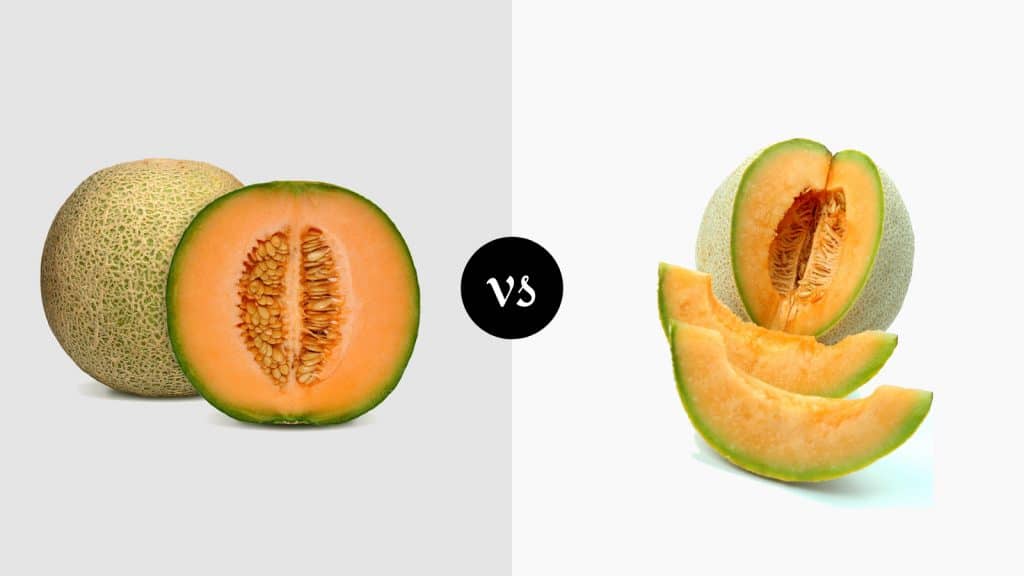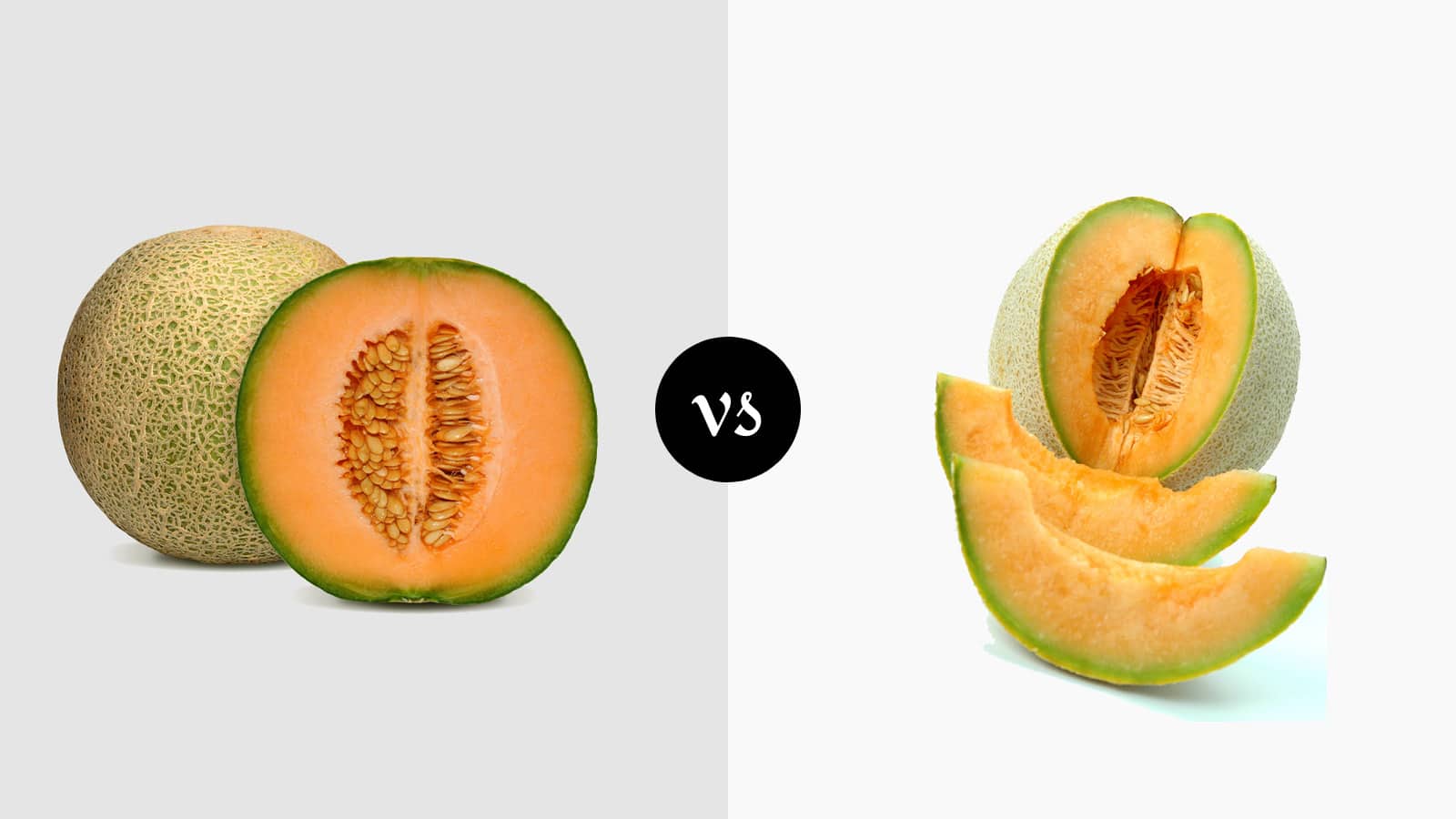
Cantaloupe and Athena melon are two popular varieties of muskmelons. Both are grown all over the world for their nutritional benefits and delicious taste. If you are a gardener and have a sweet tooth, this article is for you.
Today, we will be comparing these two refreshing fruits hereafter. Since both are widely grown, there have been many debates on this topic. Read on to learn the differences between them.
Below is a detailed comparison between cantaloupe and Athena melon.
| Features | Cantaloupe | Athena Melon |
|---|---|---|
| Taste | Sweet | Sweet |
| Sunlight requirements | 6-8 hours | 6-8 hours |
| Season | Summer | Summer |
| Watering requirements | 1-2 inches every week | 1-2 inches every week |
Cantaloupe vs Athena Melon
Cantaloupe
Also known as sweet melon in South Africa and rockmelon in Australia and New Zealand, cantaloupe is a famous fruit from the muskmelon species. It belongs to the Cucurbitaceae family of plants.
Some other fruits of this family include watermelon, pumpkin, zucchini, etc. It is an edible fruit, and its seeds are safe to consume as well. Cantaloupe melons can weigh between 0.5 to 5 kg depending on their growing environment. They have bright orange flesh and a distinctive tan-green rind.
The rind is usually covered in a net-like pattern and has a pale orange color. However, it may vary depending on the variety. Cantaloupes are eaten raw and can also be used in salads and desserts. A perfectly-grown cantaloupe has a sweet taste.

They are readily available at grocery stores, but growing them at home is more rewarding as home-grown fruits are grown with care and taste better. If you are to purchase cantaloupe melons from a store, choose those with firm skin. Moreover, full-sized cantaloupes usually taste sweeter.
Nutritional Benefits
Cantaloupe offers many benefits to those who consume it. For starters, it is an active source of vitamins, antioxidants, and minerals, such as manganese. As we all know, antioxidants help prevent cancer by protecting your body from cell damage.
They also fight free radicals in your body. Free radicals have been linked with aging and numerous diseases. Furthermore, cantaloupes are beneficial for the skin as well.
They are rich in vitamins A and C that improve your skin health and protect it from damage caused by the sun. In addition to that, they reduce the risk of many heart and respiratory diseases.
Having said that, it is important to note that eating too many cantaloupes can be harmful to the kidneys as they are full of potassium. Moreover, it may have several other detrimental health effects on your body, including digestive problems, diarrhea, and stomach cramps.

Growing Method
It is crucial to know the ideal growing conditions for cantaloupes if you intend to grow them at home. Growing them is an absolute cinch as long as you provide the right conditions. The maintenance requirements are pretty similar to that of watermelons and other varieties of melons.
Choosing the Perfect Location
Like most other plants of the Cucurbitaceae family, cantaloupes also love the heat. So, plant them in a place where they will get enough sunlight. They need around 6-8 hours of full sun to grow properly. If they don’t get sufficient sunlight, their color won’t be as bright, and the taste will also be different.
So, plant them in a sunny place. It is important to note that full sun does not necessarily mean that you must place them under direct sunlight. It means that they require at least six hours of sunlight to survive.
Soil Requirements
For the best growth, grow your cantaloupe plants in well-drained soil. For those who do not know, well-drained soil is the one that lets water percolate through it at a moderate rate. So, if you are growing cantaloupe plants in containers, do not forget to make drainage holes in the pot.
Without a proper drainage system, the roots of the cantaloupe plant may rot. This is because if these plants remain soaked in water, there will be a time when roots won’t be able to take in more water. This situation will likely lead to dehydration.

Discoloration in leaves is a common symptom associated with root rot. So, if you notice that the leaves of your cantaloupe plants have changed their color, see if their pots have drainage holes. In case they don’t have one, consider relocating them to some other pot with drainage holes.
Apart from that, be sure to plant them a few inches apart from each other. They are sprawling plants and tend to spread out while growing. Keep in mind that overcrowding is harmful to cantaloupe plants as closely-planted ones will have to fight for nutrients and sunlight.
Water Requirements
As far as the water requirements are concerned, cantaloupe plants need a lot of water to thrive. So, provide them with at least 1-2 inches of water every week. As the fruits begin to grow, consider reducing your watering gradually as overwatering can split the rinds of cantaloupes.
Athena Melon
Now coming to Athena melon, it is another type of muskmelon. Like cantaloupe, Athena melon is also a member of the Cucurbitaceae category of plants. It is basically a hybrid variety of cantaloupe. Expectedly then, its appearance and taste resemble a cantaloupe very closely.

Talking about its appearance first, the Athena melon has an oval shape, and most species are yellow and orange. Its rind is tougher and is covered by a net-like pattern. When fully developed, it weighs around 5-6 lbs and is bulkier than a cantaloupe.
Since it has a higher sugar content, it has a sweeter taste as compared to cantaloupe. It can be used in all the recipes that call for cantaloupe.
Nutritional Benefits
Athena melons offer lots of amazing health benefits. For starters, it has high water content and keeps your body hydrated. It is rich in fiber, which is known to improve the digestion system and reduce cholesterol levels.
It is a nutrient-dense fruit and is quite low in calories. Furthermore, it also regulates blood pressure, thus protecting your heart from many diseases.
Growing Method
The growing method of the Athena melons is also quite similar to cantaloupe as it is also a heat-loving plant and thrives in hot weather conditions. Make sure to plant it in an area that receives direct sunlight for 6-8 hours.
If it’s not growing properly, you can fertilize the soil to help it grow vigorously. Lastly, you will also have to take care of its watering requirements and water it regularly. Make sure not to overwater it, as it can also lead to dehydration.
Final Verdict
Cantaloupe and Athena melon are two of the most famous varieties of muskmelons. They have similar maintenance requirements and are quite easy to grow.
While both are intensely nutritious and have great health benefits, the mild taste makes cantaloupe the clear winner.
